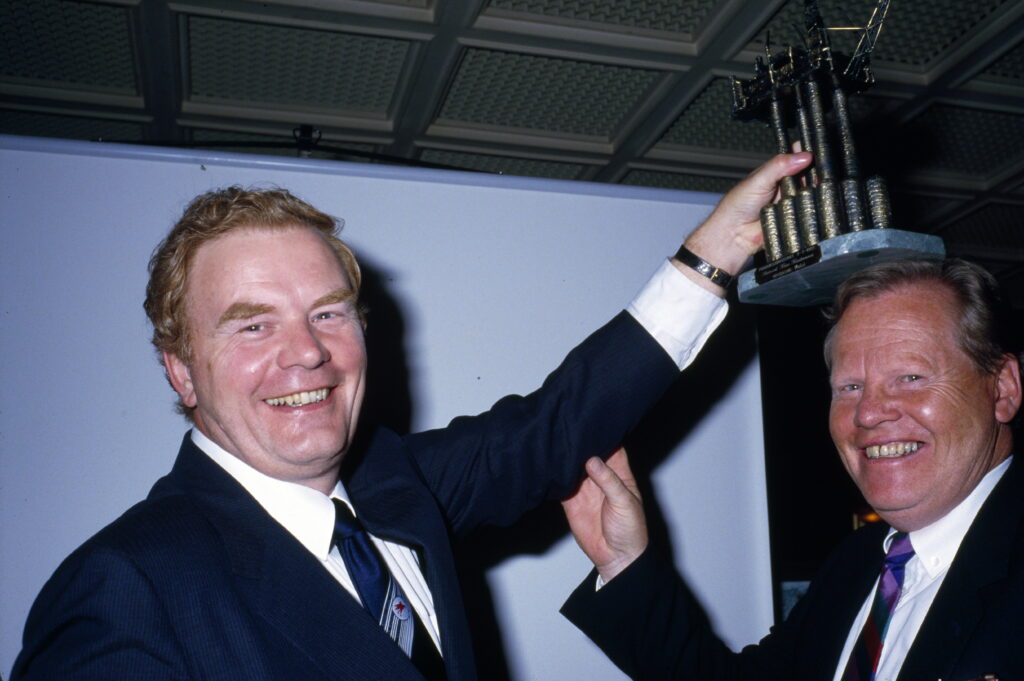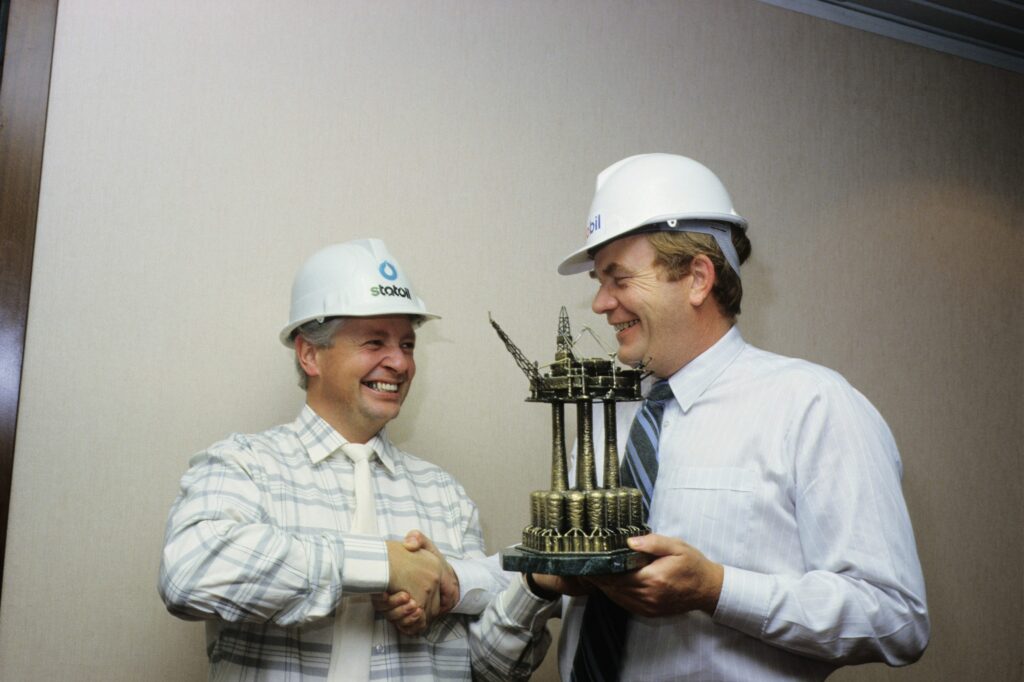Disputing the Statfjord operatorship

Norway’s share of Statfjord ranks as the largest oil field on the NCS. Mobil had been appointed operator when the licence was awarded in 1973. [REMOVE]Fotnote: Annual report, Norwegian Petroleum Diectorate 1981: 48; Nerheim, Gunnar 1996. Norsk Oljehistorie, bind 2, Norsk Petroleumsforening, Leseselskapet: 39. The field was discovered in 1974 and declared commercial the same year.[REMOVE]Fotnote: Hanisch, Tore Jørgen and Nerheim, Gunnar, 1992, Fra vantro til overmot, vol 1, Norsk Oljehistorie, Norwegian Petroleum Society, Leseselskapet: 375-377. Its first platform, Statfjord A, came on stream in 1979, and was followed by the B and C installations in 1982 and 1985 respectively.[REMOVE]Fotnote: The Statfjord area. https://www.equinor.com/energy/statfjord, accessed 27 April 2022. A licence condition for making Mobil operator was that Statoil would take over this role a decade after the field had been declared commercial.[REMOVE]Fotnote: Lavik, Håkon, 1997, Statfjord. The largest oil field in the North Sea, Statfjord group, Stavanger: 86; see also pages 85-114 for a detailed presentation of the operator dispute, and Lavik, Håkon, Changing the operator, https://statfjord.industriminne.no/en/2019/10/30/changing-the-operator/, accessed 27 April 2022; see also “Hovedplan for overføring av operatøransvaret for Statfjord og lisens 037”: 1 (Source: SAST, Pa 1339 – Statoil ASA, D/Dm/L0123: Rapporter, 1985-198: 8) (from the Statfjord archive).
Optimistic plans
From as early as 1977, Statoil had worked “continuously” on preparing to take over as Statfjord operator.[REMOVE]Fotnote: Minutes, board meeting, Statoil, Oslo, 27 September 1984, item 8/84-3 (Source: SAST, Pa 1339 – Statoil ASA, A/Ab/Aba/L0002: Styremøteprotokoller, 26.01.1979 til 28.06.1985, 1979-1985). That indicated the importance attached by the management to securing this opportunity.[REMOVE]Fotnote: Minutes, board meeting, Statoil, Oslo, 27 April 1979, item 4/79-5 (Source: SAST, Pa 1339 – Statoil ASA, A/Ab/Aba/L0002: Styremøteprotokoller, 26.01.1979 til 28.06.1985, 1979-1985). Deputy CEO Henrik Ager-Hanssen could inform the board in June 1979 that “agreement prevailed between Statoil and Mobil that it was realistic to aim at a takeover of the operatorship in 1984-85”.[REMOVE]Fotnote: Minutes, board meeting, Statoil, Oslo, 29 June 1979, item 7/79-2b (Source: SAST, Pa 1339 – Statoil ASA, A/Ab/Aba/L0002: Styremøteprotokoller, 26.01.1979 til 28.06.1985, 1979-1985). This was to prove overly optimistic.

Although Mobil had initially accepted the operator change, strong opposition to its actual implementation existed in the US company.[REMOVE]Fotnote: Lavik, Håkon, op.cit: 85. However, Mobil’s chances of winning political acceptance for such a stance were slim as long as Labour remained in government. The Statoil management, for its part, was concerned to secure the operatorship in part to build up experience. Lessons thereby learnt could be transferred to other projects, such as Gullfaks. In early 1980, the company’s leadership therefore expressed a desire to bring forward the operator takeover on Statfjord.[REMOVE]Fotnote: Minutes, board meeting, Statoil, Oslo, 21 February 1980, item 2/80-2a (Source: SAST, Pa 1339 – Statoil ASA, A/Ab/Aba/L0002: Styremøteprotokoller, 26.01.1979 til 28.06.1985, 1979-1985); See also minutes, board meeting, Statoil, Stavanger, 20 August 1984, item 7/84-2b (Source: SAST, Pa 1339 – Statoil ASA, A/Ab/Aba/L0002: Styremøteprotokoller, 26.01.1979 til 28.06.1985, 1979-1985) and minutes, board meeting, Statoil, Oslo, 27 September 1984, op.cit. The fact that Labour was still in government was no disadvantage in this respect.
Conservatives take office
But a good general election showing for the Conservatives in the autumn of 1981 held out brighter prospects for Mobil getting its way. Prime minister Kåre Willoch’s appointment of Vidkunn Hveding as minister of petroleum and energy gave a clear signal of the new direction in oil policy. As deputy chair of Statoil’s board in 1972-74, Hveding had not always been in agreement with chair and Labour member Jens Christian Hauge.[REMOVE]Fotnote: Johnsen, Arve, 1988, Statoil-år. Utfordringen, Gyldendal: 93 and 107; see also minutes, board meeting, Statoil, Stavanger, 25 January 1974, item 4 (Source: SAST, Pa 1339 – Statoil ASA, A/Ab/Aba/L0001: Styremøteprotokoller, 05.10.1972 til 14.12.1978, 1972-1978: 46). With his return in an even more powerful position, it would be, as Willoch put it, “more difficult for Arve Johnsen to dominate the government’s oil policy”.[REMOVE]Fotnote: Willoch, Kåre, 1990, Statsminister, Schibsted: 287. Hveding would later also return to the Statoil board and be heavily involved in Johnsen’s departure over the cost overruns at Mongstad.
Who rules?
Johnsen questioned whether the Willoch administration was promoting the national interest by taking a negative view of transferring the Statfjord operatorship to Statoil. The prime minister riposted by asking whether Johnsen or the government ruled Norway.[REMOVE]Fotnote: Lerøen, Bjørn Vidar, 2002. Droplets of black gold. Statoil 1972-2002. Statoil: 155 and 156.
The outlook for cross-party agreement in the Storting (parliament) on this issue looked initially bleak. Nevertheless, a constellation emerged in the standing committee on industry which played a very important role in persuading the non-socialist government to agree to the change.[REMOVE]Fotnote: Lavik, Håkon, “Statfjordsaken”, Norsk oljemuseums årbok 1999. Norwegian Petroleum Museum, Stavanger: 75-76. Key participants in this context were Labour’s Finn Kristensen, Conservative Arnljot Norwich, Reidar Due from the Centre Party and Svein Alsaker of the Christian Democrats.[REMOVE]Fotnote: Lerøen, Bjørn Vidar, 2020, Født til rikdom. En reise i Norges oljealder, Cappelen Damm: 273.
In 1984, the Storting voted in favour of transferring the operatorship. This was took effect on 1 January 1987.

Retaining Statfjord
The conflict between the Conservatives and Labour over the Statfjord operatorship represented one of the biggest political debates in Norwegian petroleum history, which centred on the issue of Statoil’s size and power.
A political solution was reached on this disputed issue in the mid-1980s with Statoil getting its “wings clipped”. Put simply, the state took direct control over a large proportion of the cash flow – both income and expenses – from the licences which the company was involved in. Statoil’s voting power in these holdings was also reduced. Labour’s condition for agreeing to such a reduction in the company’s financial muscle was that its interest in Statfjord – its biggest source of revenue – should remain untouched.[REMOVE]Fotnote: For further details about the wing-clipping, see the separate article as well as, for example, Krogh, Finn E, 1987, Reorganiseringen av Statoil. Intensjon, prosess og utfall – en analyse av beslutningsprosessen, master’s thesis, University of Bergen.
The field thereby became a key to the solution of this issue, with its destructive potential for the oil policy consensus which had prevailed in Norway. That gave Statfjord a central place in Statoil’s history – in an operator context, as a cash cow and as a way out of a demanding political position.
arrow_backAmericans look to Norwegian gasVictory over Mongstad expansionarrow_forward